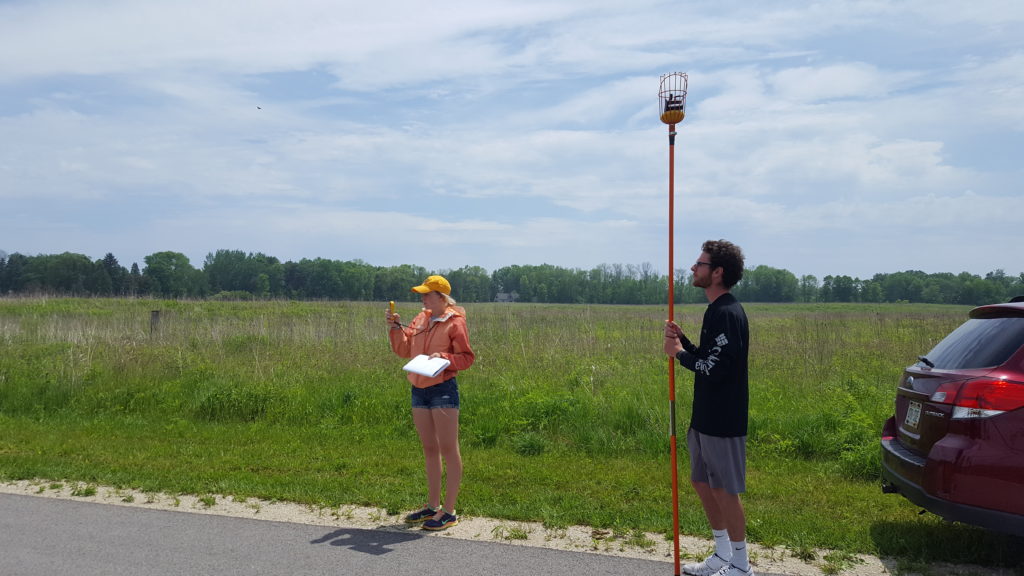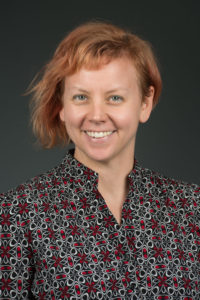
UW-Eau Claire students Molly McIlquham and Kyle Geib use an ozone monitor to measure the air at the same height at every stop during their fieldwork along Lake Michigan. They also record the local conditions, like temperature and wind speed, as measured by a hand-held weather meter.
A faculty-student team of Blugold researchers is helping scientists better understand how ozone is produced over Lake Michigan, findings that could help communities and industries in three states identify strategies for improving air quality.
“This project can impact communities and industries in Wisconsin, Illinois and Indiana,” said Dr. Patricia Cleary, an assistant professor of chemistry at UW-Eau Claire. “If we have a better understanding of how ozone gets produced over the lake, we can better predict and model when bad air quality episodes occur. That understanding may potentially provide solutions to bad air quality in the long term.”
The Lake Michigan area has a complicated history with non-compliance of air quality standards because of the urban emissions from the Milwaukee-Chicago-Gary urban areas as well as the confinement of those emissions over Lake Michigan, Cleary said.
Elevated spring and summertime ozone levels are an ongoing air quality challenge along the lake’s coast, Cleary said, noting that monitoring indicates that levels often exceed the 2015 National Ambient Air Quality Standards for ozone.
Production of ozone over Lake Michigan combined with onshore daytime “lake breeze” airflow is thought to increase ozone concentrations preferentially at locations within a few kilometers of the shore.
When pollutants move back onshore, we tend to see higher ozone at shoreline communities in Wisconsin, Cleary said.
Cleary became involved with the 2017 Lake Michigan Ozone Study after learning about it from Tim Bertram, a colleague at UW-Madison.
“I shared my research with him and he thought I could make a contribution to the team,” Cleary said.
Cleary is working to develop an unmanned aerial vehicle platform for doing atmospheric measurements and for some time she has worked to understand the air quality around Lake Michigan.
Her hope, Cleary said, was to get a drone plane operable for the summer project, but there were multiple crashes so she opted not to fly it near Lake Michigan.
“Instead, we took our ozone sensor over to the Sheboygan area and conducted ozone gradient studies by car,” Cleary said. “We had to drive to different locations, take measurements, drive to another location and take more measurements. They were long days, but pretty fun. In all, we conducted five different sampling days over the course of the campaign when ozone was predicted to be high at or near the lake.”
The UW-Eau Claire team did its fieldwork in May and June, acquiring significant amounts of data.
“Now begins the long process of analyzing all of the data that was acquired by all of the different research teams,” Cleary said. “We will all pool the data into one large archive and use the data sets from multiple platforms — including aircraft, field sites, auto routes and shipping — to better understand how ozone was being produced over this period. We must get to work on what it all means.”
Six student researchers are working on the project with Cleary this summer.
It’s a great opportunity for the students because atmospheric field campaigns are unique experiments that involve an incredible amount of collaboration, Cleary said.
Having that kind of experience as an undergraduate student will help them gain important research skills, which will serve them well in the future, she said.
“I have seen my students understand how to prioritize their work to acquire decent data under time constraints,” Cleary said. “They need to figure out what we get done by when, and what the minimum achievable goals are that we can meet. They have also seen that sometimes fieldwork requires long hours and short notice.
“I think participation in this activity has broadened their views on how science operates within a greater community, sometimes with setbacks and failures.”
Student researchers include Mario Sanchez, an applied physics/dual degree mechanical engineering major from St. Paul, Minnesota; Kyle Geib, an applied physics major from Hartland; Jacob Dai, a chemistry major from China; Molly McIlquham, a summer National Science Foundation Research Experience for Undergraduates student who currently attends Chippewa Valley Technical College; Andrew Faris, a May UW-Eau Claire geology and environmental science graduate from Chippewa Falls; and Wil Blouin, a geography major from Madison.
The students already have been invited to present and interpret some of the project results to experts in the field.
The current project is a collaborative multi-agency field study that brings together university researchers with federal and local agencies.

